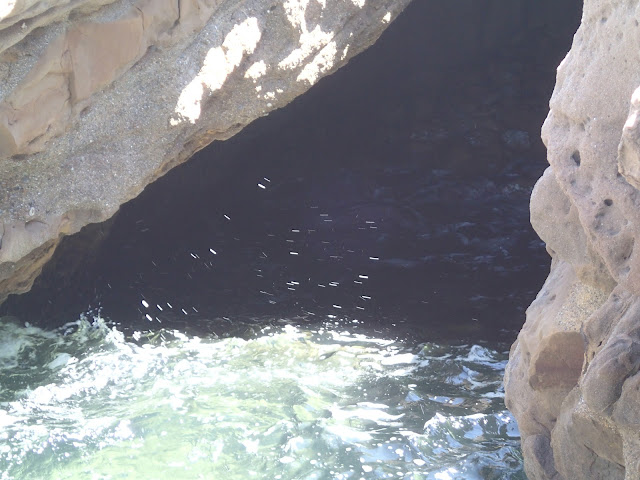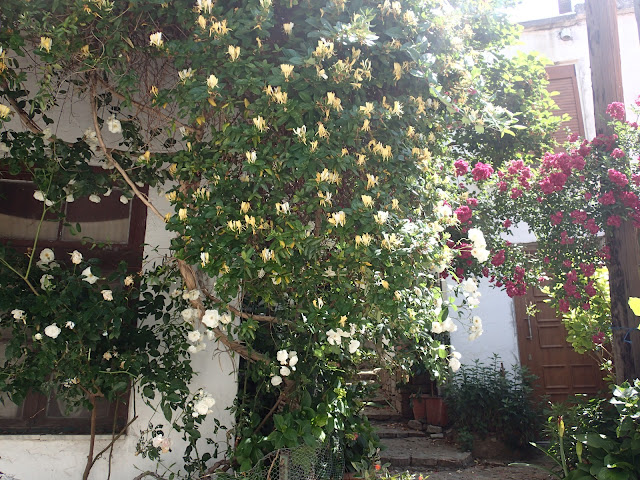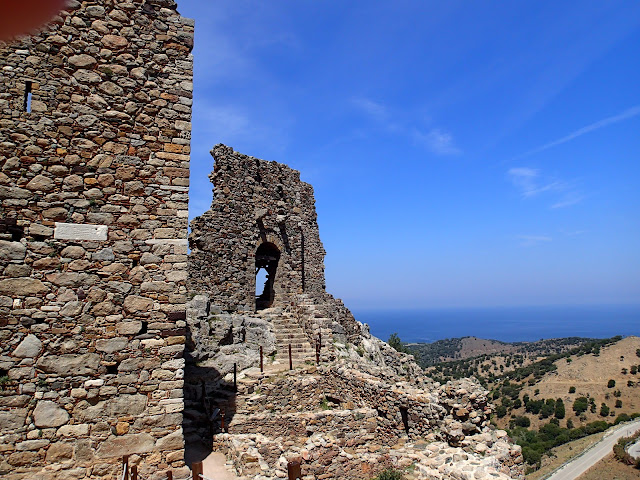We were woken at 4am on Thursday, May 10th, at
Evstratios by the arrival of the Hellenic Seaways ferry, as promised by the
port police. We went back to sleep and got up early to leave for Myrina, Limnos
at 7. We had a speedy motor-sail in a Force 3 southeasterly and arrived at
Myrina, having covered 21 miles, at 9.50. We went stern-to the quay in Myrina,
where there were already four yachts,
including Paddy and Sally on Skylark, who
had gone from Mytilene to Ayvalik, to check out of Turkey, then back to Lesbos
before crossing to Myrina the day before.
Myrina is a very attractive, very Greek, quite large and
apparently prosperous town, with a big castle up on the hill, big beaches and narrow
winding streets. It even has municipally-owned Boris bikes, though the bikes had not yet been installed.
We walked up narrow lanes, over the hill,
to look for a laundry, stopped at the promenade on the northern side of the town,
then went
shopping, before having an excellent lunch of grilled sardines and baked feta
at a taverna in the little fishing boat harbor.
During the afternoon more
yachts came in – the Russian skippered charter we had been alongside in Plomari;
Miguel, a Spanish fisherman in a Dutch registered yacht who had been with us in
Agios Evstratos; and later a huge new Bulgarian Moody 54DS. Sally and Paddy
came for a drink before we had dinner aboard and an early night.
Friday, May 11th, was a grey day with more wind
from the north and spots of rain. After breakfast we walked up to the enormous castle
on a large rock outcrop, which divides the town in two.
The castle was originally Byzantine, started in 1186,
and probably built on the site of the ancient acropolis. It was then expanded
by the Venetians and later by the Ottomans. It was damaged when it was besieged by the
Russians in 1770 and occupied by the Germans in the Second World War, when it
was bombed, but it is still very well preserved, with very good information
panels and fantastic views of the town and surroundings (and across to Athos
when the visibility is good). On the way
up we met some of the little wild deer who live here, and we met more inside
the castle.
We walked all the way around the castle and up to the top,
 |
| The entrance |
 |
| The Mosque |
 |
| The barracks |
 |
| The top of the inner castle |
taking
in the views.
We came down from the castle, collected our laundry, went
shopping and pottered around until lunch. After lunch we walked all-round the
bay on the north side of town. The Archaelogical Museum was closed for restoration,
but we visited the very interesting site of prehistoric Myrina, with the
remains of houses dating back to the beginning of the third millennium BC, together
with Polyochni, the oldest city in Europe.
At its peak it is estimated to have
had a population of 3,000. When we got back to the boat we did some odd jobs,
had drinks with Paddy and Sally and had dinner aboard. By amazing coincidence
Paddy had been at school with Lin’s brother, John, though he is a few years
younger, and Sally had run a lymphoma charity, so supporting Simon.
On Saturday, May 12th, we hired a car for the day
and drove around the island. We went first to Moudhros, where we stopped at the
East Moudhros military cemetery, mostly filled by those who died of wounds from
Gallipoli, but also a group of White Russian refugees from the civil war.
Moudhros Bay was where the ships supporting the Gallipoli campaign were based
and to which the hospital ships brought back the wounded. Moudhros town was not
very interesting – a scruffy town with a scruffy harbor. There was just one yacht
there, the Dutch ketch that we had been alongside in Plomari – an indicator of
how few yachts there are up here is that we keep meeting the same people.
After Moudhros we drove over to Poliochni on the east coast.
This was settled at the beginning of the third millennium BC, about the same
time as Myrina and earlier than Troy. The city had a population of up to 1800,
with defensive walls, paved streets, drainage and two large communal buildings,
one probably a grain store and the other an assembly hall. It was abandoned
after its destruction by an earthquake around 2000BC.
 |
| Part of the defensive wall |
 |
| The main street |
 |
| One of two large wells |
There was a building on the site for storing tools which was probably a reconstruction of one of the ancient houses.
The city sits on a hill
overlooking a windswept bay.
The remains were well preserved and well signposted,
with a very informative little museum.
After Polichni we drove up to Kabireio, a sanctuary of the
kabiroi, originally dating from around the seventh century BC with later
additions, including a Roman sanctuary.
There was not very much to see, though
the setting was dramatic, on a clifftop with views over to Samothraki and
layers of volcanic rock in contorted shapes. We then climbed down some steep
steps to see the cave in which Philoctetes, the Trojan War hero, was abandoned
by his comrades until his gangrenous leg healed. There was a sign forbidding us to go the cave,
but the custodian told us that we
could get into the cave by wading through the sea, but the water looked quite
deep and was rough with waves rolling in.
The rock formations were very striking, with layers of contorted volcanic rock.
By now it was lunchtime and we were getting hungry. We found
a café in the small town of Kondopouli,
where we had a beer and club sandwich,
before driving down a dirt track to Ifestia, the most important city on Limnos
in classical times, the other side of the bay from Kabireio. Most of the city
is unexcavated, but there are the remains of the theatre.
As at the other
sites, we were the only visitors, and this time there was not even a custodian
there, although we spotted him walking over to the site with his dog. When he
arrived we offered to pay, but he just said ‘no tickets’. We drove back to Myrina,
passing the reputed volcano,
around the south coast, with views of Ag
Evstratios and Mount Athos, getting back to the boat in time for tea.
Limnos is mountainous, with dramatic volcanic outcrops, on
the western half and pretty flat on the eastern half, indented, with a lot of
sandy beaches. In the east there were large wheat fields, quite a lot of cows,
sheep and horses, and lovely wild flowers in the meadows and along the roadside.
The roads were almost empty and we saw very few tourists or tourist facilities.
There was an incomplete resort on the hill at Kabireio, which seemed a strange
place to build a resort, and beach resorts on the west coast, but it is
amazingly undeveloped for tourism, despite having an airport with the longest runway
in the Aegean.
When we got back, two Russian charter boats arrived, having
had a wet and windy passage from Halkidiki. In the evening, we went out to
dinner with Paddy and Sally in an indifferent restaurant on the northern beach.
On Sunday morning, May 13th, we got up to be treated
to a trumpet serenade from a ragged military squad who marched along the quay
to their drums and stopped facing a closed up building opposite our mooring
place (we later discovered that they were saluting not the closed-up building, but the raising and lowering of the flag on the castle above!).
In the evening they marched with drums and trumpets from the end of the
quay to the same place, singing as they went. We had a quiet day, in the
morning walking over the headland to the south to look down on the next resort,
then up to the church overlooking the harbor. In the afternoon we did odd jobs
and cooked dinner aboard. Sally took our picture,
We got up at 6 on Monday, ready to sail to Samothraki. The
deer from the castle had come down to the quay where they were eating the
grass. A passing car frightened them off and they started walking back to the
castle, when Simon managed to get a picture of them.
We set off at 6.50 with a
light south wind, motoring half the way and motor-sailing the other half. We
arrived at Komariotissa, the port of Samorthraki, just before 1, but then had a
problem deciding where to moor. In the end we decided to go stern-to the outer
quay, but there was a crosswind of 12 knots, the quay was high and there was no
one to take our lines. We dropped the anchor and ran back onto the quay, where
Simon tried to get ashore. He got a foothold on a ring halfway up the quay, but
there was nothing to hold onto on the top, so he fell into the water. Fortunately,
there were steps a little way along, so he could get out, and Lin backed the
boat in and threw Simon a line. The wind was too strong for Simon to pull the
boat across, so he tied the line to a ring and Lin passed another long line,
which she winched in once Simon had tied it off. So in the end we were safely
berthed.
Paddy and Sally arrived from Limnos in Skylark at about
3.30. Soon after that the car hire man drove along the quay to offer us a hire
car and promised to arrange for the fuel tanker to bring us diesel at 5.30.
Needless to say, it did not come. Paddy and Sally came for a drink at 6.30 and
the car hire man came back to tell us that the tanker could not come now, but
he would get them to come at 8.30 in the morning. We went for a very good and
very cheap dinner at a fish taverna on the quay.
On Tuesday, May 15th, we got a hire car with
Paddy and Sally, with Paddy offering to drive. We drove first to the Sanctuary
of the Great Gods, on the north coast. Sally had been told by some Italians
that it was closed because of flooding, but they had managed to walk around the
fence and find a way in. True enough, the path had been washed away by what had
obviously been a torrent running down the mountain and there were two diggers
at work repairing it.
We walked across the debris and up the remains of the
path to the museum which was ‘closed for renovation’, a traditional Greek euphemism.
We then followed the path to the sanctuary, which was even more damaged than
the path at the bottom, so we scrambled over the debris and got up to the
entrance to find that it was indeed closed. We followed rough paths round most
of the perimeter, but could not find any way in. However, we could see a lot of
the site through the fence and the most attractive thing about it was the
location.
After failing to get in to the Sanctuary or the museum, we
drove up to the Hora, which is built up the sides of a gully on the side of a
mountain.
We parked in the centre of town and walked up to the medieval castle,
which has been recently restored.
By now we were getting hungry, but could not
find a functioning taverna so we bought some pies in the baker, which we took to
a bar, To Meltemi, with a terrace overlooking the village,with a great view down to the sea, where we ate them
with bottles of the very good, though expensive, beer from the local
micro-brewery.
The bar owner had been born in Germany, where his parents had lived and worked for 35 years. He told us that much of the population of Samothraki had gone to work in Germany, mostly in Stuttgart, and many had now returned. He also told us that they had had a catastrophic storm last September, the run off from the mountains having destroyed the paths round the sanctuary and damaged many of the roads, as we were to see when we drove along the south of the island in the afternoon. He recommended the two best tavernas on the island, O Brakhos in Profitis Ilias for grills and To Akrogiali in Lakoma for fish, but by now we were full of pie and beer!
After lunch Paddy drove us through the narrow winding streets of Hora, over the pass and down to the south coast, which was amazingly green, with beautiful wild flowers. We drove up to Profitis Ilias, a mountain village, which had wonderful views along the coast,
but O Brakhos did not look
as though it was functioning. We drove back down a rugged windy to the coast
road and turned east. The road went up and down over the hills, and in every
gully the road was damaged, with masses of rocky debris around, and at one
point a bridge had been destroyed, with the river temporarily filled with
rubble and rough service on top.
We drove all the way along to the beach at Pachia Amos, a
long sandy beach with a closed taverna, which was deserted.
According to our old
Rough Guide there is a hidden spring at the end of the beach. Simon set off to
find it, but found nothing but a dried up gully. After a paddle and pushing the
car out of the sand we drove back to the harbor, where we returned the car at
about 4 o’clock. After drinks with Paddy and Sally we had bacon and eggs for
dinner and an early night.
The outer quay was full by the evening, with most boats
alongside. At about 7.30 a big Turkish catamaran came in and went alongside the
inner quay. They left their servant washing the boat, while they went ashore.
Sometime later they were told to move and went and anchored outside the harbor.
Two large trawlers came in and went alongside where the catamaran had been,
though they left early in the morning.
We got up early on Wednesday, May 16th, ready to
leave at 7 for our return journey to Leros, with Limnos as our first stop. We
said goodbye to Paddy and Sally, who were leaving for Thasos at the same time,
and set off to sail into a stiff southerly wind.































































No comments:
Post a Comment
Note: only a member of this blog may post a comment.